ホテル明山荘
Floor guide
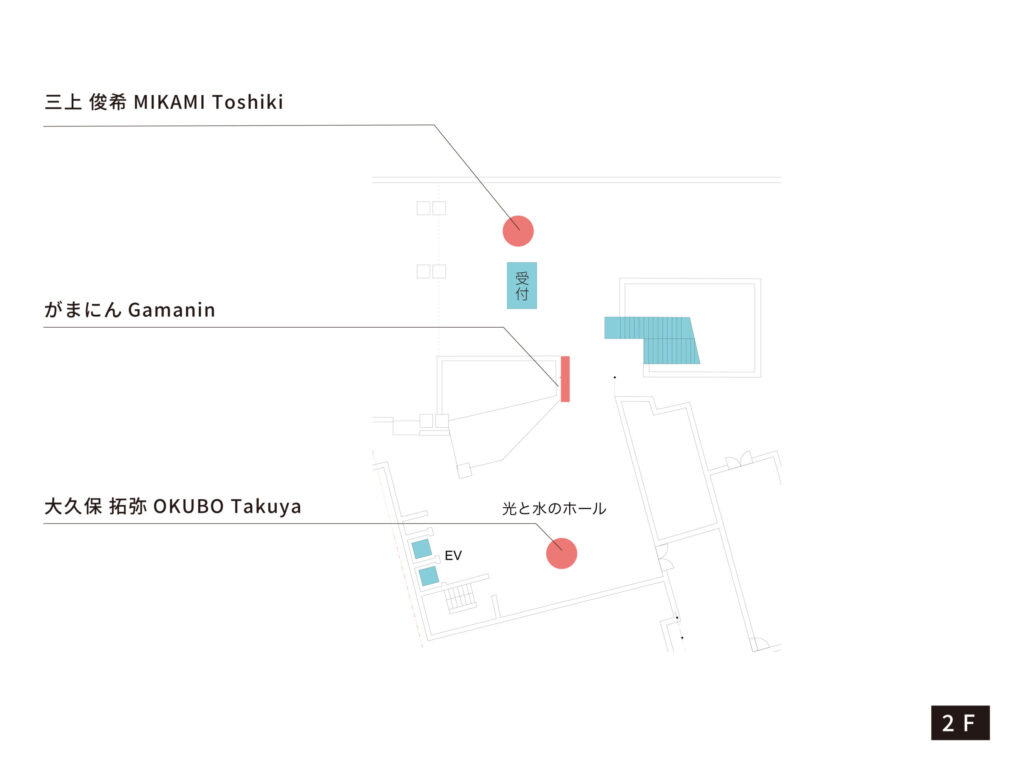

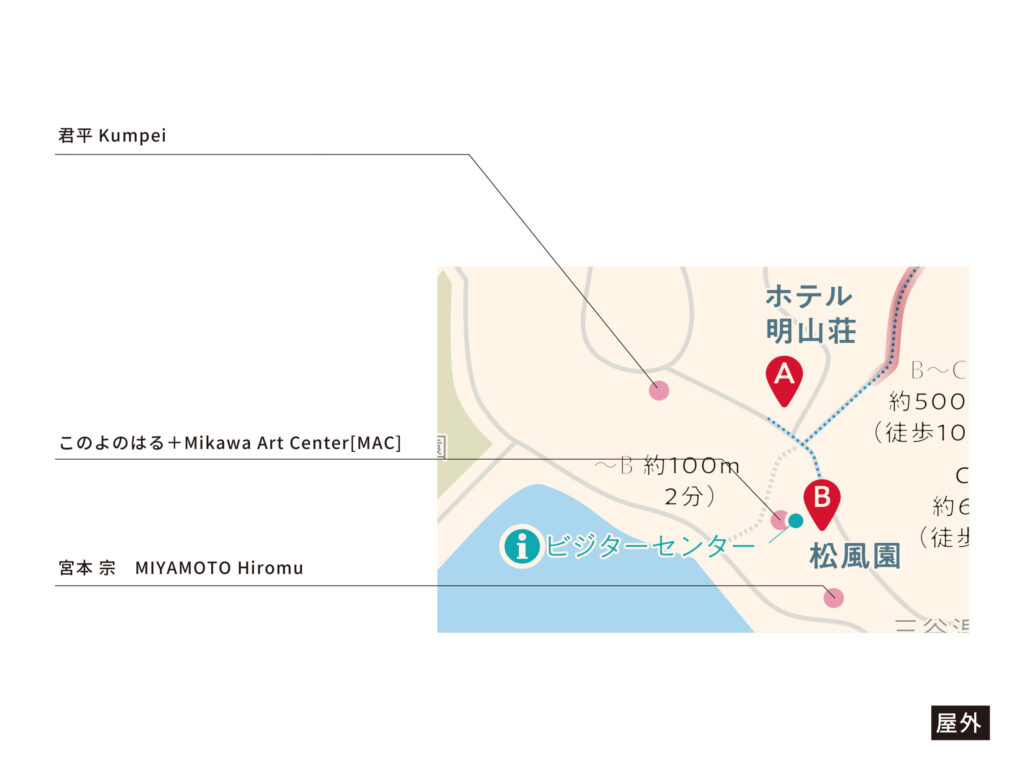
ホテル明山荘【2F】
Breath IV
三上 俊希 / MIKAMI Toshiki
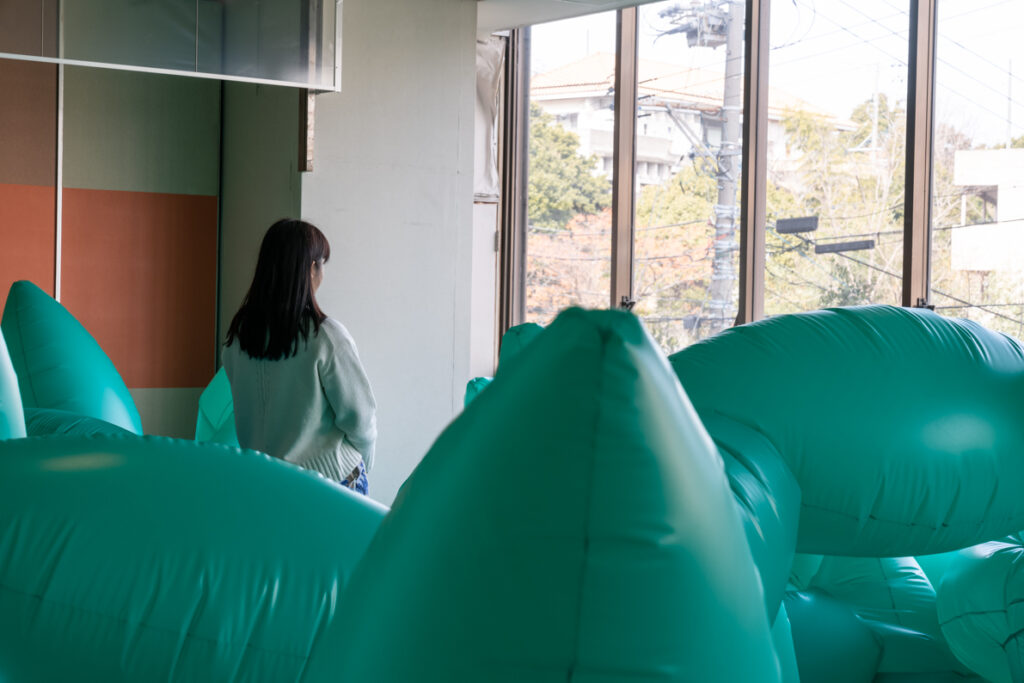
物体に脈動のような動きを与える「生命体としての彫刻」をテーマに制作をしています。
今回の作品は、人間がミクロサイズになり体内を探検する80年代の映画をモチーフに、体内で細胞が呼吸する動きをイメージしたものです。人間の血液の塩分濃度は、原始の生命が誕生した太古の海の塩分濃度と同じと言われていることから、「太古の海」というキーワードからもインスピレーションを受けています。
The theme of his work is “sculpture as a living organism,” which gives objects a pulsating movement.
The motif of this work is inspired by the 80’s movie in which a human being becomes microscopic and explores the inside of his/her body, and the movement of cells breathing inside the body. The artist was also inspired by the keyword “primeval sea,” as the salinity of human blood is said to be the same as that of the primeval sea, where primitive life was born.
会地今昔圖
カリヲ / CALIWO
この瓦版は、“大愛知なるへそ新聞”(あいちトリエンナーレ2016 [虹のキャラバンサライ] 国際展出品作品)上に同名で連載されたコーナーに使われた図版です。
「会地今昔圖」は名古屋やその周辺の地形探索や歴史、考古学、デザインや建築等にも造詣の深い名古屋スリバチ学会の方々と、日本画家であり、瓦版·浮世絵等の作品を得意とするカリヲとのコラボレーションとして当新聞社によって企画されました。学会メンバーから訊く愛知の昔の風景と現在の景色を、想像の中で混ぜ合わせてつくられた“なるへそ新聞”ならではの「今昔圖」となっています。
昔の風景の話を訊き、現在の視点から過去のディティールを紡ぎ出すという作業は、丹念なリサーチと想像の力があってこその、口述歴史絵図となっています。紙面サイズではなかなか見ることができなかった細かいディテールをご堪能いただければと思います。
This tile version is an illustration used for the serialized section of the same name on the “Dai-Aichi Naruheso Shinbun” (Aichi Triennale 2016 [Rainbow Caravanserai] International Exhibition).
The “Kaiji Konjaku-do” is a collaboration between the members of the Nagoya Suribachi Society, who are well versed in topographical exploration, history, archaeology, design and architecture in and around Nagoya, and Kariwo, a Japanese-style painter and ukiyoe (tile prints) artist. The “Naruheso Shinbun” is a unique “Konjaku-dou” (picture of the past and present) created by mixing the past and present scenery of Aichi in the imagination of the society’s members.
The work of asking about the old scenery and weaving out the details of the past from the perspective of the present is an oral history drawing made possible by careful research and imagination. They hope you will enjoy the fine details that could not be easily seen on paper size.
The surface surfaces.
大久保拓弥 / OKUBO Takuya

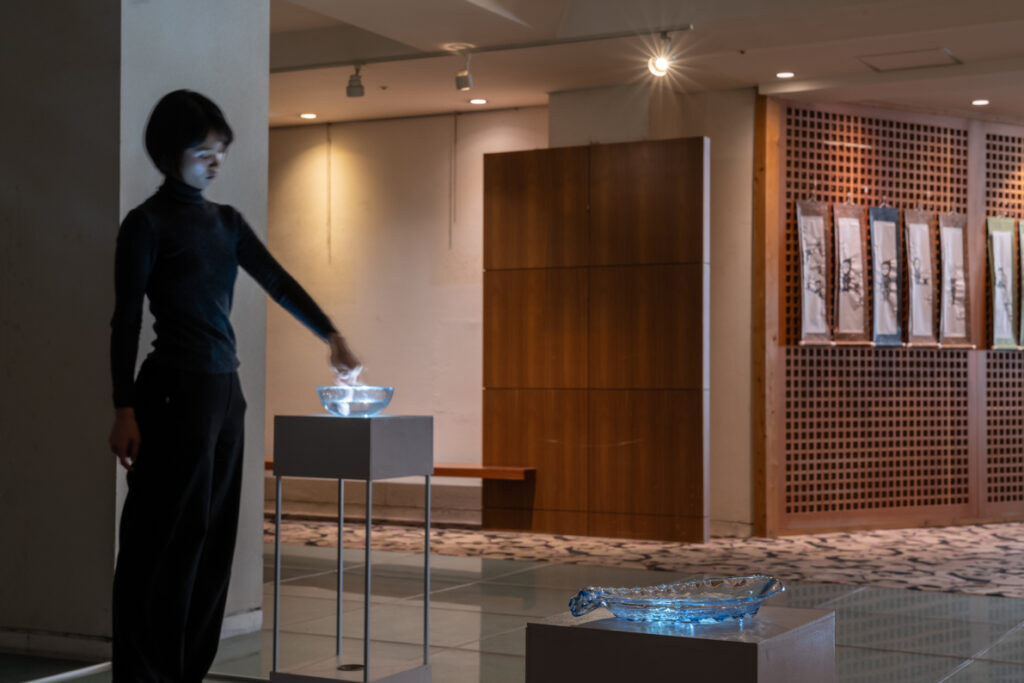
7つの展示台には、「ホテル明山荘」で実際に使用されている食器やグラスなどが置かれ、水の入ったガラスの器に触れることで、水面が天井に映し出されます。
この場所はかつて、床面のガラスタイルの下に水が流れていて、その水面が天井に投影されていました。設備の老朽化とともにその演出はなくなってしまいましたが、本作では当時の姿を再現するとともに、新たなインタラクションを取り入れています。
鑑賞者が水に触れると水面が揺れて、水の模様が現れます。日常生活において見逃してしまうほど無意識に起こり得る現象ですが、その単純な動作から生成される模様を天井に投影することにより鑑賞可能にしたこの作品では、ある種の”ととのう”ような感覚も感じられ、体験者の意識や感性を研ぎ澄ます。どうぞ実際に水面に触れて作品をお楽しみください。
什器デザイン・協力/手島拓実
The seven display tables feature tableware and glasses actually used at the Hotel Meishanso, and by touching the glass vessels filled with water, the surface of the water is projected onto the ceiling.
This location used to have water flowing under the glass tiles on the floor, and the surface of the water was projected onto the ceiling. With the aging of the facilities, that production has disappeared, but this work recreates the appearance of those days and incorporates new interactions.
When the viewer touches the water, the surface of the water shakes and a water pattern appears. This is a phenomenon that can occur so unconsciously that we miss it in our daily lives, but by projecting the patterns generated by this simple action onto the ceiling, the work makes it possible to appreciate it, giving it a kind of “Totonou” feeling that sharpens the awareness and sensitivity of those who experience it. It also sharpens the awareness and sensibility of the viewer. Please enjoy the work by actually touching the surface of the water!
ホテル明山荘【5F】
建設的な会議 Constructive Discussion
西松 秀祐 / NISHIMATSU Shusuke

2019年1月1日
7年ぶりに、家族が父方のおばあちゃんの家に集まった。父、父の弟、母、姉、僕、おばあちゃん。普段、父と母は同じ家に住み、父の弟、おばあちゃん、姉そして僕は、それぞれ一人暮らしをしている。久しぶりに集まった家族の前で、僕は一つの質問を投げかけた。『みんなで組み立て体操をしてみたい。』
一見馬鹿げた質問を、それぞれが関わり、話し合う事で、自分たちの家族のあり方を探せるのかと思った。(西松 秀祐)
January 1, 2019
For the first time in seven years, my family gathered at my paternal grandmother’s house. My father, my father’s brother, my mother, my sister, my grandma and me. Usually, my father and mother live in the same house, while my father’s brother, grandma, sister, and I each live alone. In front of my family, who had not gathered for a long time, I asked them a question. I asked the question, “What would you like to do if we could all do calisthenics together?”
I wondered if we could find our own way of being a family by discussing this seemingly silly question with each other.
みかんと座布団の相関図
西松 秀祐 / NISHIMATSU Shusuke
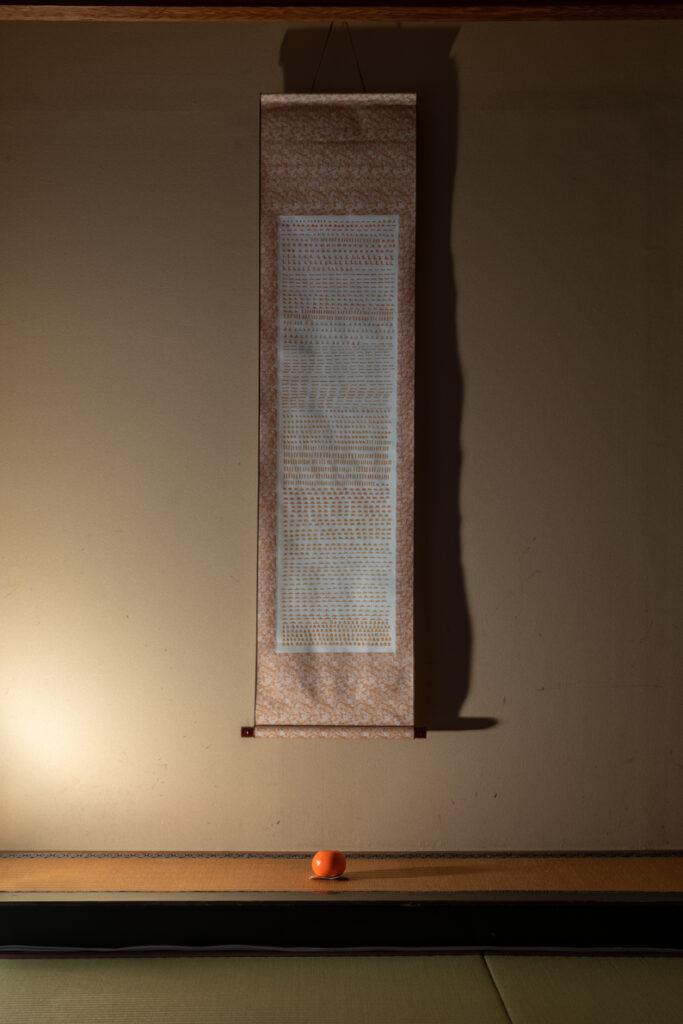
紙に水彩、または岩絵具で描かれたみかんの組み合わせの相関図と、展示空間となっている客室の、座布団の位置の相関図のドローイング。
映像作品「建設的な会議」の中で、机の上のみかんを使って組み体操の形をモデリングするシーンがあります。本作品はみかんを使って人間関係図を描く試みです。
映像作品「建設的な会議」の鑑賞者は、座布団を使用して視聴していただき、座布団の位置も自由に動かしてください。部屋のどの位置に、そしてどのくらいの距離感で座布団が置かれているか、ということに人間関係が現れます。それも展示物のひとつとして鑑賞していただきたいです。
Correlative drawings of combinations of oranges drawn in watercolor or rock paint on paper and correlative drawings of the position of the cushions in the room that serves as the exhibition space.
In the video work “Constructive Discussion” there is a scene in which the artist models the shape of a kumi-taiso gymnastic using oranges on a desk. This work is an attempt to draw a diagram of human relationships using oranges.
Viewers of the video work “Constructive Meeting” are asked to view the work using cushions and to move the position of the cushions freely. Human relationships will appear in the position of the cushions in the room and the distance between them. We would like viewers to appreciate this as one of the exhibits.
水囊 About jellyfish motif
カリヲ / CALIWO

「私にとってのクラゲとは、人の罪の象徴なのです。」
このミズクラゲは年々大発生が日本各地で見られており、その発生により漁業への悪影響や発電所の冷却水取込口への侵入など、人に対する害も多々見られています。
しかしながら、その大量発生の原因としては「クラゲが成長するのに適したコンクリート壁が海岸に増えたこと」「海水温度の上昇」「海水の汚染による富水養化に伴う餌となるプランクトンの増加」などがあげられ、これは人間の開発による環境汚染が大元だとも言えます。
人間の開発によりクラゲが発生し、その害がまた人間に返って来る。
しかし、クラゲはただ発生し人間に害をなすだけでなく、海水の純化に大きく貢献しています。海水に漂う物資をクラゲの出す粘液で固め海底へと沈めることにより、海面部の生物では分解できなかったものを海底の生物が分解できるようになります。そして海底の土へと還るのです。クラゲは水の汚染を濾過する役割を担っています。それはまるで『創世記』におけるノアの方舟の話で天が地上を洗い流し、浄化させるのと似ています。
“人が荒さねば大雨の降ることもないのだろう。”
To me, jellyfish are a symbol of man’s sin.”
The outbreak of these jellyfish has been seen year after year in various parts of Japan, and their harmful effects on the fishing industry and their invasion into the cooling water intakes of power plants have been observed.
However, the causes of the outbreaks include “an increase in the number of concrete walls on beaches suitable for jellyfish growth,” “an increase in sea water temperature,” and “an increase in plankton as a food source due to the increased nutrient enrichment caused by polluted sea water,” which can be attributed to the environmental pollution caused by human development.
Jellyfish are caused by human development, and the damage is returned to humans.
However, jellyfish are not only harmful to humans, but also contribute greatly to the purification of seawater. By solidifying materials floating in seawater with the mucus produced by jellyfish and sinking them to the seafloor, organisms on the seafloor are able to decompose materials that could not be decomposed by organisms on the sea surface. The jellyfish then return to the soil of the seafloor. Jellyfish play a role in filtering water pollution. It is similar to the story of Noah’s Ark in the Book of Genesis, where the heavens wash away and purify the earth.
“If man did not wreak havoc, there would be no heavy rainfall.”
ホテル明山荘【屋外】
プランクトン plankton
君平 / Kumpei
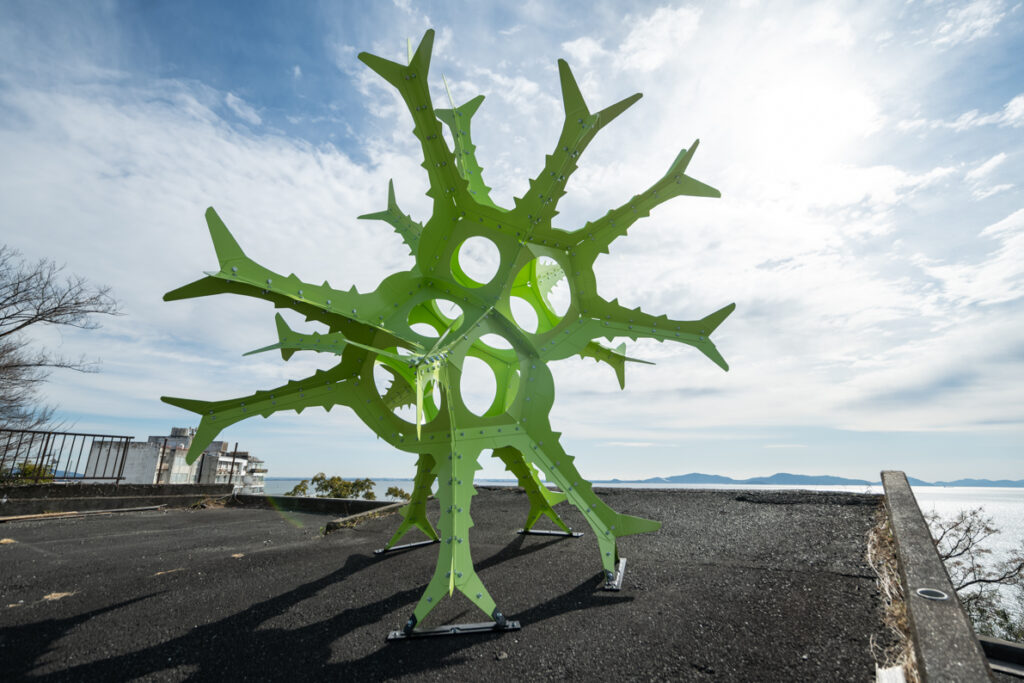
1997年から鉄の立体作品を中心に作家活動を始め、2012年に琵琶湖のプランクトンをモチーフに鉄の彫刻作品を制作。以降、プランクトン・花粉・微化石など小さな生命を「鉄」の重厚さと大きなスケールで表現しています。近年は地域の歴史や自然に関心を広げ、プランクトン・花粉・微化石のほか、絶滅危惧種などをモチーフに大型の立体作品を制作し、博物館研究者や地域と連携したプロジェクトやワークショップにも取り組んでいます。
In 1997, he started his career as an artist focusing on three-dimensional works in iron, and in 2012, he created an iron sculpture with the motif of plankton in Lake Biwa in Shiga prefecture. Since then, he has been expressing small lives such as plankton, pollen, and microfossils with the gravity of “iron” and on a large scale. In recent years, he has expanded his interest in local history and nature, and in addition to plankton, pollen, and microfossils, he has created large three-dimensional works with motifs of endangered species, and is involved in projects and workshops in collaboration with museum researchers and the local community.

